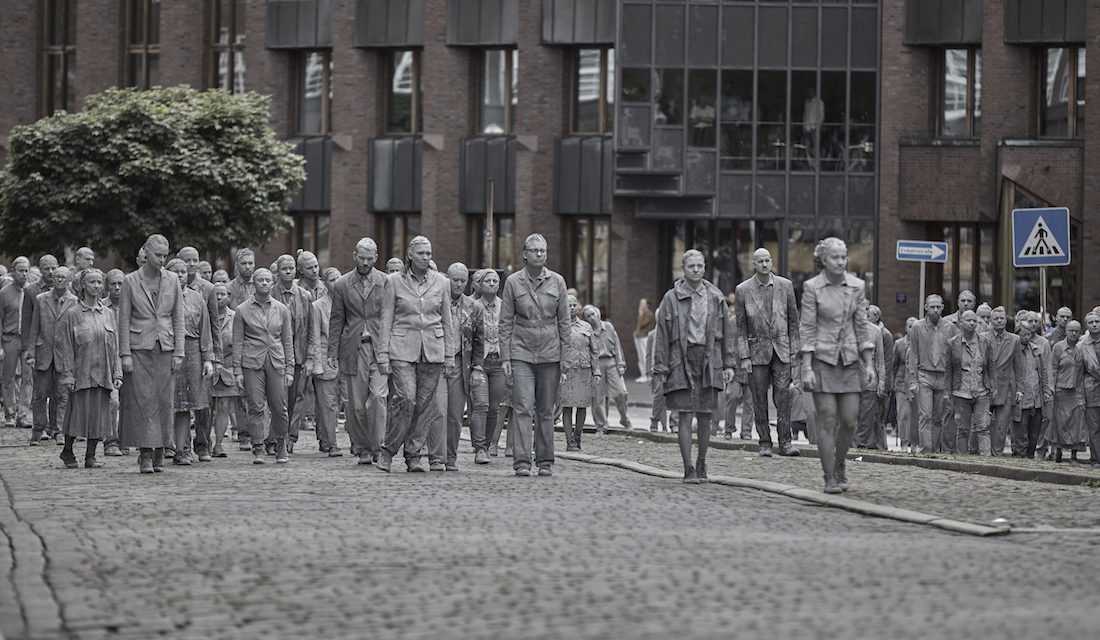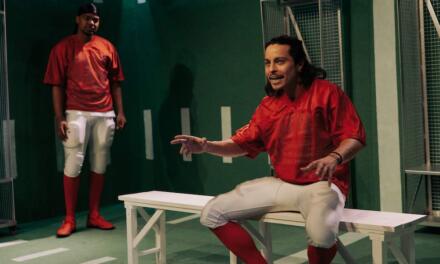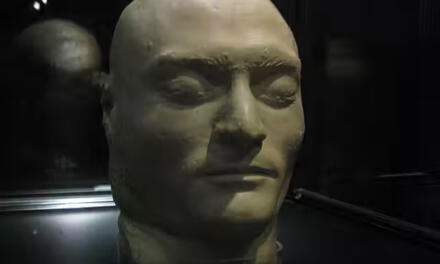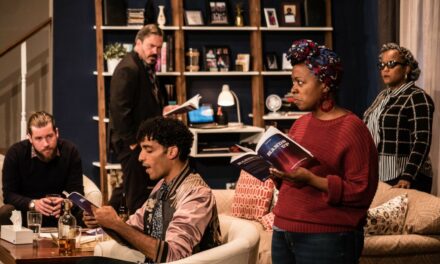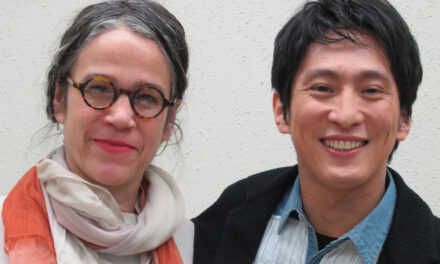“The grander nationalist ostentatiousness gets, the smaller and quieter bodies become.”
Nationalist questions have been addressed regularly in performing arts over the past years. Etcetera asked curators Nat Muller and Sandra Noeth to enter in conversation about the connection between the body and identity politics. During the editing process Tunde Adefioye, member of Etcetera’s circle of advisory editors made some notes alongside this dialogue.
Nat Muller:
It would be an understatement to say that we live in a time of global disquiet and polarisation. In Europe alone we’re struggling among other things with blatant neo-liberalism, the aftermath of an economic recession, right-wing populism, increased xenophobia and nationalist fear-mongering, and a steady dismantling of socio-political institutions that have kept WWIII at bay. Much of the nationalist discourse is steeped in this nostalgic idea of a mythical past of grandeur and of exclusionary identity politics (usually a singular male, white, and straight voice).
Sandra Noeth:
What is interesting is how, in dialogue with this, questions of nationalism have been prominently discussed in the field of contemporary dance and performing arts in recent years. Artists, cultural workers, and institutions across Europe have been critically addressing the relation between the body and identity politics in curated programs, symposia, etc. Choreographers Farah Saleh and Isabelle Schad [1], as two examples, have examined from their individual sets of contexts how movement and gestures feed and interact with the formation of a community and the experience and embodiment of collective identity. Artist Manuel Pelmus comes to mind, as well. In his work Preview (2007) he connects the in/visibility of moving bodies in the public sphere with official memory both in Western and Eastern European art markets to broader questions of representational politics. And much more critical work can be mentioned that addresses the concept and practices of the embodiment when it comes to the body’s potential for collective image-making, for instance in regard to queer bodies or bodies in a refuge. This reminds us of how essentialism, ephemerality, and authenticity have historically [2] been associated with the human body and misused for diverse ideological projects. It also helps to understand how collective identity is scripted, rehearsed, internalized, aestheticized, legitimized, but also deconstructed and de-familiarized by bodily, physical means. Bodies appear as sites of power where sovereignty, territoriality, and legitimacy are negotiated. Dance and movement-based forms of expression have historically been used to train and skill the body and, at the same time to maintain the hegemony of collective experience. Choreographically speaking, the inscription of collectivity (and its violent repercussion) was not limited to a physical level but affected vision and imagination as well.
“There has to be a debate how power, colonialism, and race are inscribed on the body, instituted and perpetuated.”
My question is what these performative negotiations of “becoming-collective,” of positioning oneself as an artist, as an institution and citizen, almost in a somatic sense, that I am evoking here, are witness of. And what is the critical potential that arts might offer on an epistemic level? In other words: how might specifically movement-based forms of artistic expression and the aesthetic experiences that they provide enter a field of nationalistic identity politics that is largely based on narratives and strong imagery? [3] How do we eventually draw on the latter in staging, performing, legitimizing ourselves? How might the focus on the experience that the body introduces complicate, destabilize the latter, introduce brittleness and help de-normalize what has become familiar and accepted, from the outside, but also within one’s own community?
Nat Muller:
Your note of nationalism creeping into contemporary practices is a case in point. It happens in different guises. I would add that currently there’s a very fine line being walked between (often misguided top-down) policies of diversity and inclusion, and debates around cultural appropriation [4]. In other words the question of who is allowed to speak for–and borrow from–whom is very current. These are discussions that urgently need to be had, in particular in the context of decolonizing institutions and curatorial practices. The result is often polarising and Othering and produces a narrow identity politics on all sides of the spectrum. In the case of policy, it still leads more often than not to tokenism. For example, the tendency to place cultural practitioners of color and non-Western backgrounds in advisory committees when the subject addresses diversity or postcolonial issues, but not calling on their expertise for other matters. This is a disservice to all parties involved. Here I am reminded of the recent controversy over Dana Schutz’ painting Open Casket (2016) during the last Whitney Biennial. Schutz, a white American artist, made an abstract painting of Emmett Till, a 14-year old African-American boy who was lynched in Mississippi in 1955. His white killers were acquitted and the boy’s murder became iconic for the Civil Rights Movement.
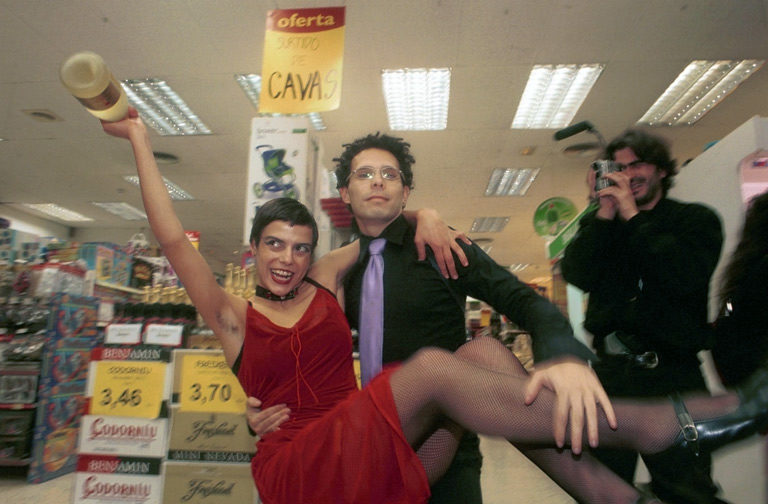
Yomango Eres Tu, Rodeados por la prensa. Photo Credit: Creative Commons
Schutz was accused of appropriating an image of black suffering for her own financial gain. During the biennial opening black artist, Parker Bright protested by placing his body between the painting and the audience for hours, i.e. literally blocking it from view. His t-shirt said “No lynch mob” on the front and “Black Death Spectacle” on the back. The way the protest was staged, whether we agree or not if Schutz had a right to tackle this subject, was very effective because the artist used his body in a performative way, underlining that it is a black, racialized, and moreover underrepresented body within American art institutions. It also forcefully draws the viewer to reconsider how they look at black bodies. In a way, his body became a pars pro toto for the protest. In my opinion, it is far more powerful than artist Hannah Black’s letter [5] calling for the artwork to be destroyed [6]. First of all, I feel very uncomfortable when artists demand the destruction of other artists’ work, no matter how much they disagree with it. Secondly, there has to be a debate how power, colonialism, and race are inscribed on the body, instituted and perpetuated. For this, as you have noted previously, collectivity is a necessity, so coalitions and allegiances can be forged.
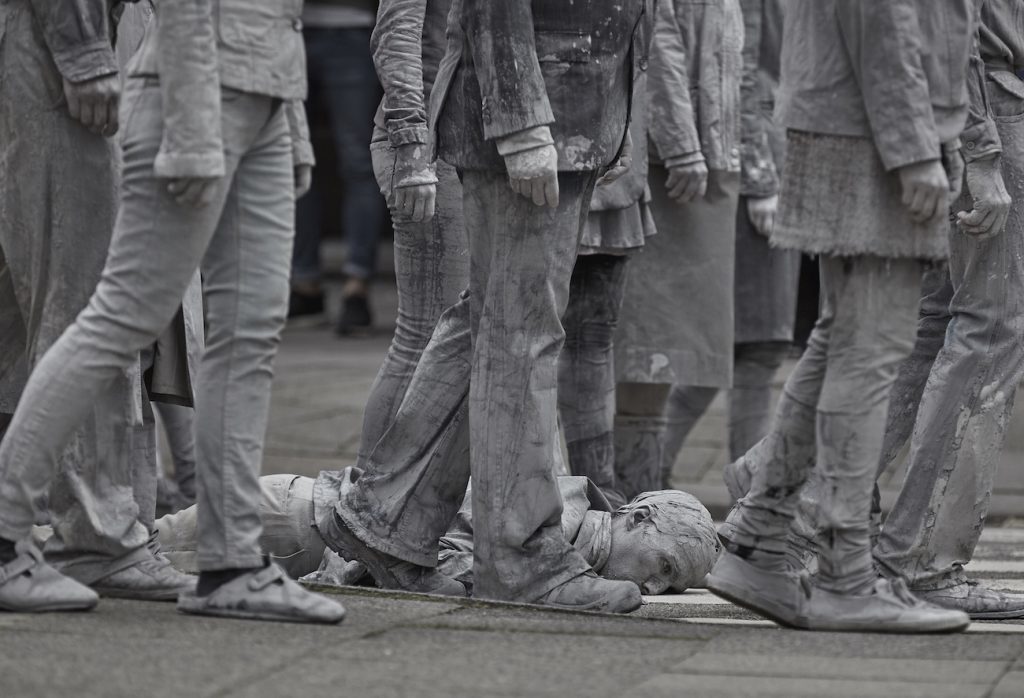
1000 Gestalten. July 5, 2017, Hamburg, G20 Summit. Photo Credit: Andrea Ruester
Sandra Noeth:
I agree, even though these examples demonstrate as well the boundaries of collectivity. Sometimes, when entering these debates as a curator or as a researcher-observer, you feel trapped: multiple collectivities seem to emerge from different or concurrent value systems, collective identities, hierarchies and their respective politics at stake and enter into the competition and interfere. I am thinking of French choreographer Latifa Laabissi who is of Moroccan origins and performed her 2006-solo Self Portrait Camouflage at MOMA PS1 and the festival American Realness in New York in January 2017. The performance included nudity and the use of a faux-Sioux headdress and opened a heated and mediatized debate on cultural appropriation, white supremacy and lack of sensitivity and foresight. I will not go deeper into this much more complex and very loaded case [7] but limit myself to point out moments in which different collectivities, their claims and legitimacy clash: how does the fact that the artist is herself from Arab descent strengthen or soften her responsibility towards Native Americans? What’s the institution’s role in relation to the artists and audiences that they invite in initiating, reacting but also directing and controlling this process, and so on?
What happened here exemplifies, as I see it, the urgency for an ethical discussion with the body at the core in the arts field. It shows the need to find a language for a dialogue that goes beyond binary constructions, and also the importance to lay open the politics and ethics that drive all of us, above all to ourselves. To stay with the conviction that the body as such is resistant in itself is clearly not enough here.
Nat Muller:
A way of offering embodied and performative resistance to this hegemony has since the early 2000s been the zombie walk as the quintessential embodiment of contemporary apocalyptic fears. I am thinking of the 2008 Utrecht and Barakaldo Zombie Walks and seminar developed by artists Iratxe Jaio and Klaas van Gorkum that critiqued consumerism and post-industrial conditions during the global economic downturn, or the “corporate” zombies who descended on Wall Street during the Occupy Movement in 2011. The 1000 Gestalten [8] performance at the G20 gathering in Hamburg is the most recent example. Not only does it show a collective, choreographed movement of “undead” bodies through the streets, de facto reclaiming that space, but it is also as if “zombieness” transcends gender, class, race, and other identitarian markers. In Hamburg the zombies were all caked in grey clay, moving slowly and unsteadily through the city, occasionally falling to the ground: monstrous in being unassuming and drab, devoid of individual traits. A colorless ravenous mob, [9] yes, but perhaps also a very egalitarian and inclusive one, in which the collective body becomes one because there is no hierarchy, and no ideology directing it. There’s only this urge for cannibalistic consumption. In that sense the zombie’s instinct is very neo-liberal: consume without agency. Towards the end of the performance, the zombies tore off their grey attire and rubbed the clay off their faces and hair, and revealed colorful clothes and started to dance. It was a return to a joyous individualism, not only in how they looked but also in how they moved. I am obviously doing a pretty outrageous inverse reading here when describing this, but what does it mean when we cannot move as a collective anymore and only move as singular atoms. As zombies, there are definitely tactical crossovers with how (emancipatory) assemblies of bodies get together. In addition, it is quite striking how the seemingly non-ideological figure of the zombie is used as a trope countering hegemony, neo-liberalism, racism, etc. Herein lies also its Cassandra moment: in hyper-capitalism, we are perhaps all undead and uncritical consumers. So how are we to read the ambiguity of what these seemingly undisciplined bodies signify?
Sandra Noeth:
The Zombie performance is indeed an interesting example for the counter-formation of a collective body in public space, and for the specific type of resistance that it produces. When thinking of historical mass movements throughout the 20th century and the way in which they forcefully staged different ideologies into experience, some recurrent features linked to the body can be identified: the mimicry and repetition of movements and gestures, strategies of blending into a group, working towards a non-hierarchical, unison movement, etc. So choreographically or performatively speaking, rhythm was important, empathy, discipline, affect as well. In many cases, the embodiment of national and other identities was grounded and bound to the assumption of a specific community as a pre-defined or projected entity that existed in opposition to an individual body. Here, with the G20 manifestation, we might encounter a different concept of being together: the performance and the use of physicality in the Zombie-walk are not aiming at the formation of a homogeneous, identical collective bodies but actually allows for and shows a-synchronicity, ambivalences, bodies out of tune. This might suggest that we witness a collectivity that appears as a much more brittle, temporary counter-figuration in public space, as a means of protest, resistance, and agency that allows for different collective bodies that assemble on the basis of a shared political claim, and that actually integrates the experience of vulnerability and harm.
Nat Muller:
It is almost as if the zombie body is the opposite of the vulnerable bodies at risk in mass demonstrations. I am thinking about the vulnerability of these bodies during the 2011 uprisings in Tunisia, Syria, and Egypt, or the 2013 Gezi Park demonstrations across Turkey. These bodies in opposition were always branded as being “unpatriotic” and endangering national security and the national(ist) narrative. Often these activists were accused of being foreign agents or complicit in a foreign plot.
So here again is a dynamic of Othering bodies, setting the one acceptable national(ist) acquiescent body off against the body that is dissenting. To follow up on what you said, I guess there is a difference between being a witness to vulnerability and not necessarily embodying or manifesting it. Perhaps it is interesting to look at collective and performative initiatives of the early 2000s such as the Spanish shoplifting movement Yomango, which perfected choreographed shoplifting as a social critique. The Yomango crew would descend en masse on clothing chains like Bershka or Zara and incorporate elements of mime and dance in their routine. In the meantime, they had also designed devices to shoplift without getting caught. It was tongue-in-cheek, celebratory and very much an in-your-face attack on the unequal distribution of wealth, mass consumerism, and Mac jobs. All these actions were carefully documented and shared online. This is of course well before social media platforms came into play. Another example that comes to mind is the German performance collective LIGNA and their public space “radio ballets”– choreographies through which participants are directed collectively over a radio broadcast. In these performances, LIGNA explores amongst others the boundaries between public and private space, which gestures are deemed permissible or not in these realms and how movement is managed. Both Yomango and LIGNA demonstrate a sense of joyous playfulness. I wonder whether post-Occupy and post Arab uprisings [10] things have changed in terms of how spectacle and spectatorship operate. Do you feel choreographed collective actions and movement have changed?
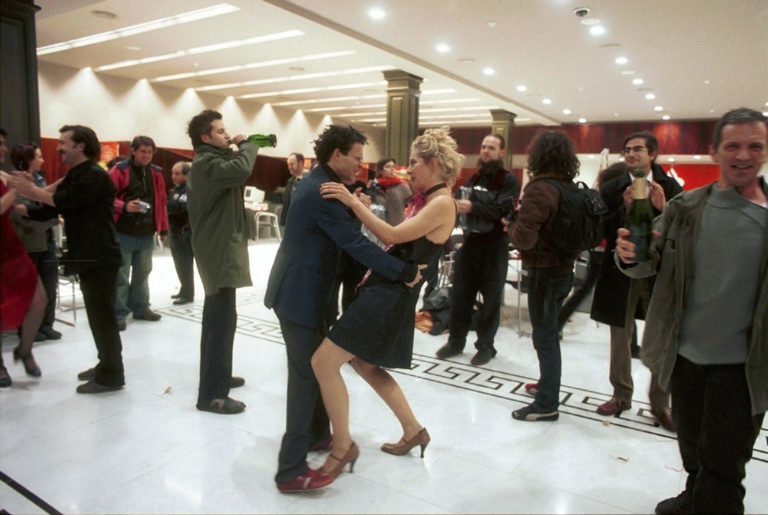
Yomango Eres Tu, Sucursal se anima. Photo Credit: Creative Commons
Sandra Noeth:
That gives lots of food for thought, but what seems to have attracted specific attention in the last years, beyond the changing politics and aesthetics that the performances interact with, is the role of spectatorship [11] that you already mentioned. That seems to be a key aspect to me in terms of the concepts and practices of non/participation that it draws on. This not only relies on how the relationship between arts and activism is conceived of, which is an on-going negotiation that many artists discuss. But for example, the absence of the body, its stillness and muteness, are used as an active means of protest alongside the mass choreographies and more explosive interventionist movements that you described. There is a specific entanglement of activity and passiveness to be observed here on a corporeal level that shows a body in resilience [12].
There is an interesting tension to be observed here: while proving a certain capacity to persist, to re-orientate and endure when experiencing physical or symbolical harm or intrusion, the body seems to be caught, in short, in between romantic ideas of resistance and an affirmative, neoliberal rhetoric of flexibility and adaptability. This not only risks to take away the visibility of the body but also its agency.
On a more general level, I am interested in how the very concepts of being-together and belonging, of standing in for a certain cause that is institutionalized through the body, have developed and range from community-based ideas to different ideas of collectivity, which reflect on the possibility and the boundaries of (physically) acting in a globalized and highly mediatized context and in often temporary and concurrent frameworks of action.
Nat Muller:
A good example of stillness and muteness as a manifestation of defiance and resilience would be Turkish artist, dancer and choreographer Erdem Gündüz’ Standing Man during the 2013 Gezi Park protests. His simple, but incredibly powerful action of standing still for eight hours at Taksim Square and peering at what the Atatürk Cultural Centre to be demolished went viral across and beyond Turkey. Many copied this action, another nod to the idea of repetition you mentioned earlier. It is as if a distributed collective body was formed through all these separate actions. Its strength really lies is reducing bodily performance to its most pure and stripped form: presence. Gündüz himself has always referred to his action in terms of a protest, not necessarily a performance, however it is interesting that these types of protest are coming from people with backgrounds in dance and performance, and that his gaze was directed towards a centre that has hosted many performances. So that to me is interesting. Going back to the idea of spectacle and spectatorship, here the spectacle is minimised, and apart from Gündüz’ primary action of being present, he is also looking: an observing witness who’s refusing to close his eyes to the injustice unfolding in front of him. So it is as if he is holding a vigil, literally watching over something, while being present with his body and being sentient. It is as if the more authoritarian and violent things grow and the grander nationalist ostentatiousness gets, the smaller and quieter resisting bodies [13] become with their movement and gesture reduced. In Gündüz’ insistence on corporeal presence there is also an ominous warning, namely that this presence in a repressive regime is exceptionally vulnerable and could disappear and turn into an absence in a split second.
[1] Farah Saleh A Fidayee Son in Moscow 2014, Cells of Illegal Education 2016, Gesturing Refugees 2017; cie Isabelle Schad / Good Work Productions Collective Jumps 2014, Pieces and Elements 2016.
[2] Tunde Adefioye: Indeed, this makes me think of the study of eugenics in the late 1800s and 1900s. A legitimate area of study that was used as justifying the inferiority of non-white bodies. Specifically giving the “authority” to the positionality of certain bodies. Bodies that are then relegated to occupying certain realms of society.
[3] TA: Makes me think of Josephine Baker dancing in Paris with a banana skirt. What place of national identity does a Black women, whose body was over-sexualized take, when she was in effect seeking refuge from the violence of racial segregation in her home nation.
[4] TA: Yes. Diversity as a “corporate strategy” as Angela Davis puts it. Tangential and parallel to that we have the discussion on appropriation. Appropriation becomes relevant when we look at the underrepresentation of certain groups in the cultural field determining policies that guide the sector.
[5] TA: In many cases destruction or censoring of any type of art is not encouraged. But one must think about the type of hostility Schutz’s work is for certain groups of individuals. Why for example are statues that remind us of a “glorious” Civil War past being uprooted? Largely because of the context that many in the US still live in today. In the age of real violence against Black and Brown bodies perpetrated by the state, memories of the past serve to create a severe psychological trauma for many. A type of distress that some feel can only be addressed through a physical excision of the offending art, statue, etc.
[6] Cfr. for a good discussion: Coco Fusco, “Censorship, Not the Painting, Must Go: On Dana Schutz’s Image of Emmett Till.” Hyperallergic. Published 27 March 2017. https://hyperallergic.com/368290/censorship-not-the-painting-must-go-on-dana-schutzs-image-of-emmett-till/
[7] TA: Complex is a correct summary of the situation. The history for some has not faded and thus it is still hard to accept someone who is non-Native American using the headdress. This is even more loaded considering the controversy that the court case against the Washington Redskins and their mascot. That case that exploded in the media in 2015-16 underlined the continuing struggle for Native Americans to make sure that their ancestors’ blood was not shed in vain. That they will continue to fight for control of how their bodies (likeness) is being used by the mainstream society and institutions that sometimes have direct ties to the history of oppression and massacres that their ancestors lived through. A non-sequitur but not fully irrelevant is considering the fact “Arab” individuals within the US census (and thus society) for many years have been classified as “white.” This of course creates a sense of domination that for many years encapsulated the type of interactions that people in underserved, often poor communities would have with Arabs. The Arabs in the communities were often seen as dominating the economies in the neighbourhoods they lived in. This dynamic started shifting though after the war in Kuwait and was even more sharply altered after the 9/11 attacks. Where both Arabs and other groups including Native Americans and Blacks, started to witness the oppression and discrimination of Arabs, especially those who identified as Muslims. Nevertheless the power dynamic still remains. So having an Arab put on a Native headdress in a white institution that sits on Native American land, becomes a loaded act.
[8] Cfr. https://1000gestalten.de/en/the-collective/
[9] TA: Both are certainly a legitimate reading of the gray zombies. But what this need to create a “colorless” mob points to is also the desire for a post-racial society. One that was vociferously promoted during the Obama era. Certainly a desire for an utopian ideal. One that could lead to false assumptions of where different “oppressed” bodies are in a collective union. Maybe a more desired representation, would be what happened at Standing Rock. Where different bodies of different colors came together and “received” the blows and violence that the Native Americans on those lands were receiving. What this type of collective stance also hints to is how accomplices should operate. It is often the ally that commodifies and risks appropriation. If we are to see appropriation as a risk. But an accomplice attempts to stand by and with the body(-ies) of the oppressed to collectively stand against the forces that aim to oppress.
[10] TA: Post-Occupy and post Arab uprisings, I guess would be Black Live Matters which was also present at Standing Rock. What is evident here is a non-hegemonic, non-hierarchical, diffused form of organizing. It is also informative to note that one of the queer woman (Patrisse Cullors) that was responsible for initiating BLM is also interested in using theatre as a tool of dynamic and collective transformation. In different cities, she (they) has directed and guided individuals from the community towards creating storytelling theatre as a way to empower themselves. Initially through masterclasses that collect stories while creating a safe space.
[11] TA: Guess this spectatorship also (or overwhelmingly) occurs online.
[12] TA: It might be interesting to explore Judith Butler’s critic on the word resilience. In essence how it is a word used by certain institutions and systems of oppression as a way to validate their use of force on bodies that are perceived as “resilient.” Bodies that will continue to return to activism or do “harm” unless they are violently suppressed.
[13] TA: It is maybe and/and not and/or. The Women’s March on Washington was certainly not small nor quiet. Though if you return to Turkey and the peace petition that was signed by academicians in Turkey and outside like Noam Chomsky is an example of quiet.
This post originally appeared in Etcetera on November 13, 2017, and has been reposted with permission.
This post was written by the author in their personal capacity.The opinions expressed in this article are the author’s own and do not reflect the view of The Theatre Times, their staff or collaborators.
This post was written by Nat Muller and Sandra Noeth.
The views expressed here belong to the author and do not necessarily reflect our views and opinions.

